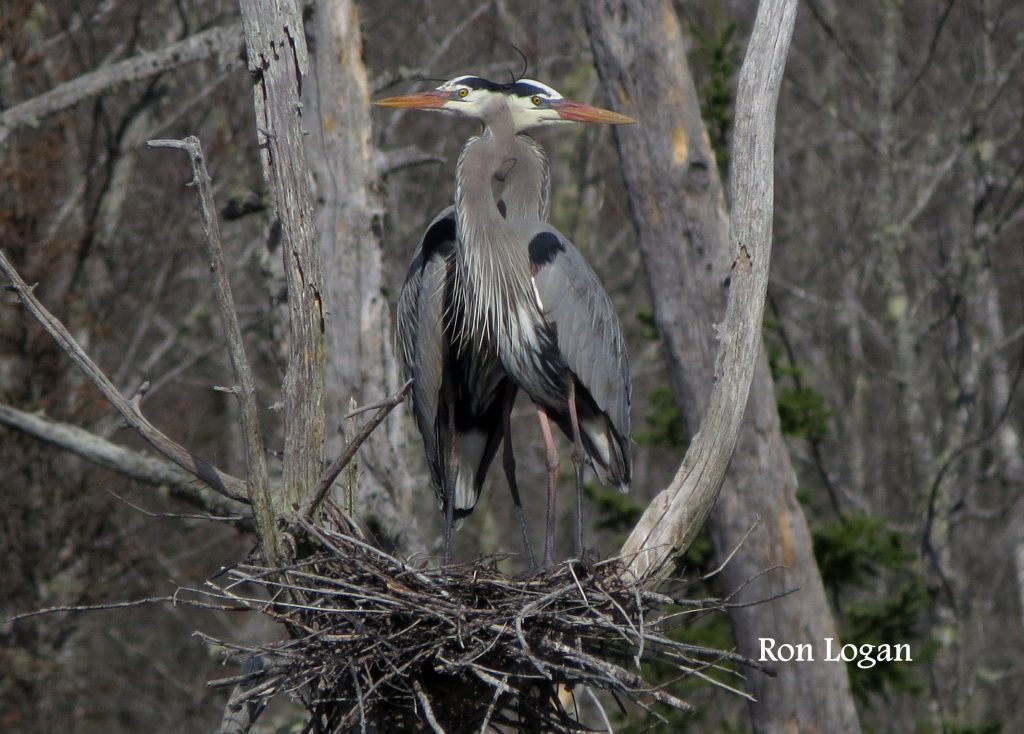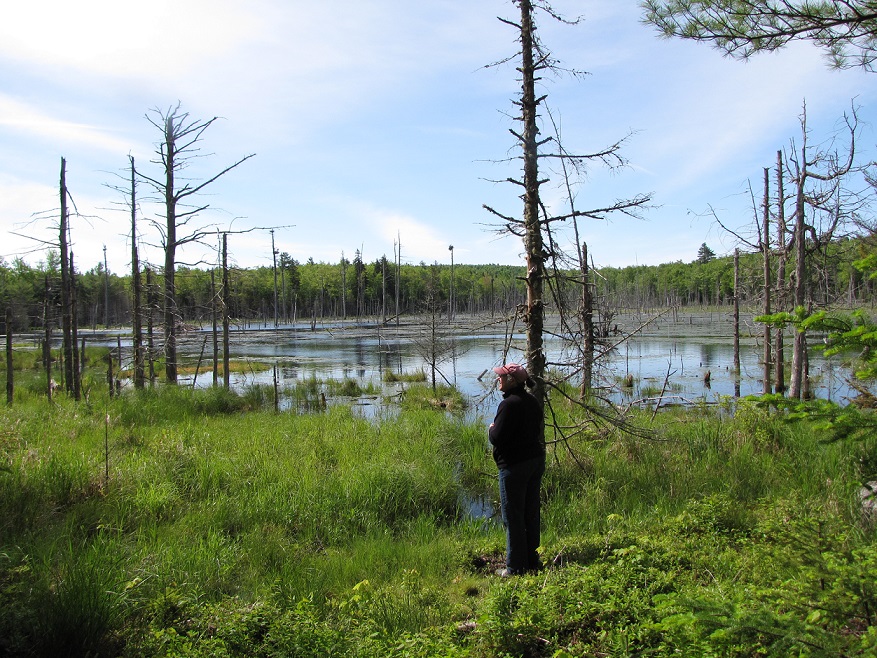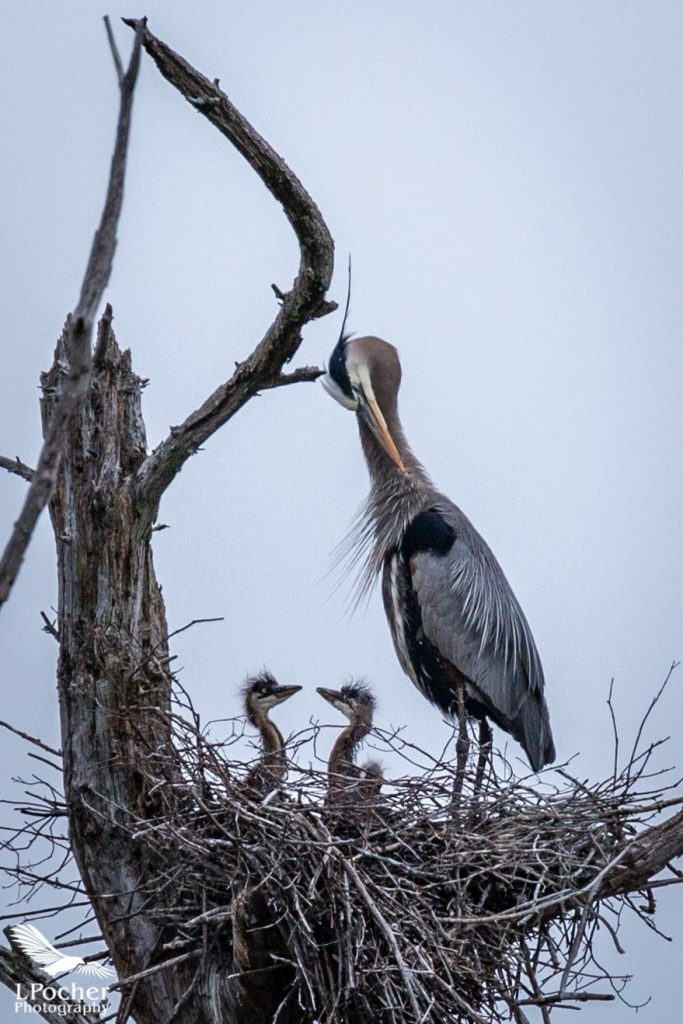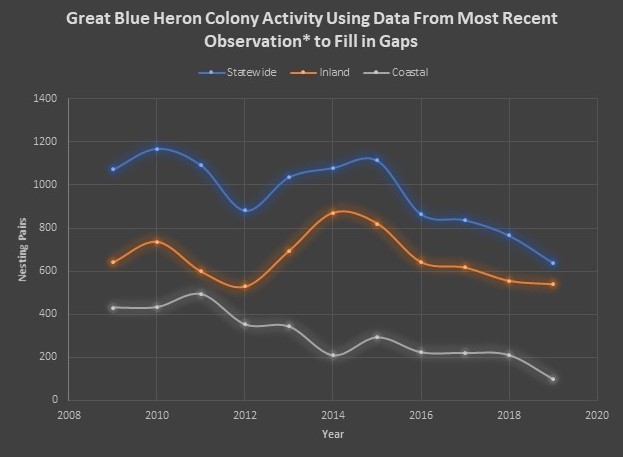April 6, 2020 at 11:03 am

How about we forget about what’s going on in the crazy world for just a moment and think about the month of June 2019, which is when Heron Observation Network Volunteers conducted most of their colony visits last year.

Everything is vibrant green except for maybe the snags that precariously hold heron stick nests. There is bird song all around – red-winged blackbirds singing “honk-a-ree,” tree swallows chattering, and wood ducks whistling as they take flight. Every now and then you can also hear young herons begging to be fed. Most nests have young in them, some are small newly hatched fluffballs that can barely lift their heads above the rim of the nest, others may be nearing the size of their parents and only distinguishable by their awkwardness. Suddenly, the young in several nests stand up straight and alert and get very excited – that’s when you notice an incoming adult likely with a fishy meal to share. The adult stands on the edge of the nest, barely paying attention to its boisterous nestlings for what seems an eternity. Finally, a nestling takes the adults’ bill in its bill and pulls its head down into the nest – there’s a scuffle, squawking, wing-flapping, and its hard to tell whose head and neck are whose. Then, they lift their heads and some swallow down a healthy morsel, temporarily satiated. The adult lifts off and vanishes beyond the horizon and all is quiet in the nest again.
Ahh, life in a heron colony – oh how I am looking forward to getting back out there this year!

Before we begin a new season, I’d like to share last year’s results. This was our 11th year of monitoring great blue heron colonies across the state with volunteers. This past year, 59 volunteers actively monitored 83 colonies, and IFW staff and contractors covered another 28. Those 59 volunteers recorded 225 hours in the field watching colonies, and recorded driving 3,664 miles to get to and from the sites. That is a big investment, and it is so appreciated because every single hour and mile counts as match for federal funding. We are hoping to use this accumulated match in 2021 to help fund another Dual-Frame Aerial survey to obtain a second breeding population estimate.
Volunteers and staff conducted 168 ground visits, covering 111 colonies. They observed 536 nesting pairs at 57 active colonies; the remaining 54 sites had 92 unoccupied nests. The average colony size was 9 nests, and the largest colony visited had 60 nests! This colony is in a live white pine stand and was viewed from a distance on the ground and counted from the air.
If we look at all 383 historic and active colonies in Maine and use the most recent data collected for each, our estimate for this year’s nesting activity is 640 pairs at 73 colonies, the lowest we have seen yet. The drop in 2019 is within both our inland and coastal colonies. Year to year fluctuations are to be expected as birds shift colonies, but we are now seeing an overall statewide decline of 40% since we began closely monitoring colonies in 2009. We hope that 2020 will buck this trend.

As we get ready for a new season, my goals for 2020 include increasing each of the following:

The number of colonies monitored - It’s always a challenge to find the right colony for each volunteer. It often depends on how far volunteers are willing to travel and how much bush-whacking to a site they are willing to do. It also depends on whether we can obtain landowner permission to access the site on foot. Not all sites are easy to get to or easy to view. There are also many colonies that need monitoring but may be inactive, which may not appeal to some. It is important to monitor inactive colonies for five years before taking them off our list. I will do my best to find colonies for all who are interested.

The number of volunteers who enter their data in to the Citizen Science Portal - Volunteers have been so patient while we work through the kinks of our Citizen Science Portal! I really hope everyone will try it again this year and continue to use it, because this is the most efficient way for the data to be reported. Don’t hesitate to contact me with any questions or challenges so we can work through them together.

The number of volunteers who remember to record the number of hours and miles - A lot of volunteers who did not use the portal also did not report their volunteer time and mileage this year. This information is a key component to the Heron Observation Network program and is vital for leveraging federal funds for future research and monitoring efforts. There are fields on the data sheets and in the Citizen Science Portal for hours and mileage. Volunteers, please be sure to fill those in going forward.
Thank you to all the volunteers who monitored colonies in 2019 and prior! Every year your efforts contribute to our knowledge of Maine’s great blue heron population - both the threats they face and the places they are thriving. I hope everyone is excited for spring and all that comes with this season of renewal!